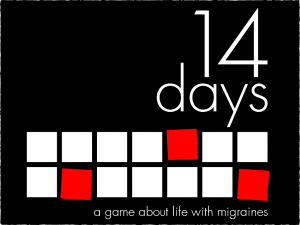 Tearing up over a headline on the cover of People magazine, which I happened to glance at when I walked past it at the pharmacy, was the telltale sign that depression symptoms had returned. I was already pretty sure they were back, it’s why I was at the pharmacy.
Tearing up over a headline on the cover of People magazine, which I happened to glance at when I walked past it at the pharmacy, was the telltale sign that depression symptoms had returned. I was already pretty sure they were back, it’s why I was at the pharmacy.
Although I was perfectly mostly happy with Wellbutrin, I had to reduce my dose because, thanks to a migraine attack, my brain is now so sensitive to Wellbutrin’s side effects that I am massively dizzy on the dose that manages my depression. Cutting my dose back, the dizziness finally became manageable (though still present) on Monday… at the same time it stopped keeping the depression at bay.
I’m already frustrated by the needs of my ever-changing brain, but I was hopeful a new antidepressant would help me balance all my competing needs. Or I was until my insurance denied coverage. Now my doctor has to jump through constantly moving hoops to prove that, yes, this is the drug I need.
While I wait to see if her appeal will be approved, I can either be so dizzy that I can’t move my head and can’t look at the computer or I can let my depression symptoms build so that I have no motivation to get out of bed and cry at everything. Either way, I can’t work, can’t run errands, and can’t do anything around the house. I could try another yet another generic antidepressant, though I’ve already tried many, and would have to decide which I prefer, potentially gaining a ton of weight or losing interest in sex.
I don’t have much faith in my doctor’s authorization being accepted. Since the first of the year, Hart’s been working on a getting a doctor’s authorization approved for a drug that I was told would definitely be covered under our plan. It’s a drug he’d been taking for months, paid for by the same insurance company, until the rules changed with the turn of the calendar page. Now he’s without a drug he needs. There is a replacement, a replacement that he’s already tried. Last time it increased his migraine frequency so much that I lost sleeping worrying that he was developing chronic migraine.
I miss the days when my doctor and I got to weigh all the relevant medical factors and decide which medication was right for me. Yes, I could pay for these drugs out-of-pocket (assuming I could afford them), but I already pay a small fortune for health insurance each month. Being told a service will cover what I need, tethering myself to that service for a year, and still having to wheedle and cajole to get what that service supposedly includes is absurd. Especially when all that time spent on the phone and submitting paperwork is unlikely to result in me getting the coverage I thought I was paying for. Tell me up front whether the treatment I need will be covered so I can make a fully informed decision, don’t lock me into something then change the rules.
That’s what I’m angriest about. I understand why insurance companies don’t cover certain drugs or treatments. Yet I did everything I could possibly do to make an informed decision, including 17 hours of research, questions for my insurance broker, and hours on the phone with the insurance company. Now I have a yearlong commitment to a health insurance plan that’s not providing the coverage I was assured they would provide.
I get that health insurance is a mess right now. I get that companies are scrambling to make a profit now that they have to provide coverage to people like me. And I am grateful to be able to have any insurance coverage for my entrepreneur/freelancer household. But how is that companies are able to provide only basic information for a consumer to use to choose a plan, give half-truths (or lie outright) when asked questions, then delay coverage for months? I can’t think of another consumer service that operates this way successfully. Certainly not one that requires a commitment to paying thousands of dollars over the course of the year, then telling the customer, “Oh, wait, we’ve changed our minds.”
How is this OK? How can that happen without repercussions?
 What’s your take on this statement?: “The key to managing migraines and work is communication. It’s important to let coworkers and managers know about your condition and educate them about it.”
What’s your take on this statement?: “The key to managing migraines and work is communication. It’s important to let coworkers and managers know about your condition and educate them about it.”

 We’ve all wished we could place someone else in our migraine shoes so they can see what it’s really like to juggle the demands of the illness. 14 Days, a tabletop game, is attempting to do just that. In this two-person game, players try to manage their time and responsibilities in a two-week period never knowing when a migraine will strike. When a migraine hits, they then have to decide if it’s worth taking meds from a limited supply and what falls through the cracks.
We’ve all wished we could place someone else in our migraine shoes so they can see what it’s really like to juggle the demands of the illness. 14 Days, a tabletop game, is attempting to do just that. In this two-person game, players try to manage their time and responsibilities in a two-week period never knowing when a migraine will strike. When a migraine hits, they then have to decide if it’s worth taking meds from a limited supply and what falls through the cracks.